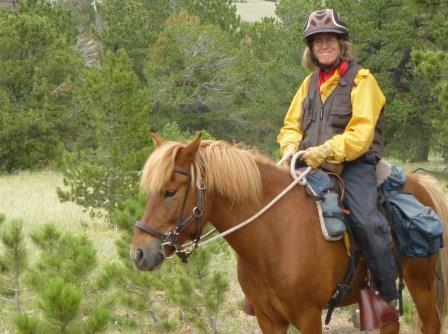
Home > Dispatches > Daily Dispatches 2014 > Daily Dispatch #108
April 18, 2014: Ride Safe: Wear a Helmet
There is often a window of time, about Twenty Seconds, in which one can read their horse, and thus take appropriate, and perhaps lifesaving action. A caveat – what I failed to mention is that accidents can and do happen, even when riding Icelandic horses. It’s for this reason that I decided to write a second, accompanying article on a subject that’s dear to my heart, which is helmet safety as this relates to accident prevention. This is my quandary. I don’t like telling people what to do. However, I know from experience that helmets save lives. Here’s my story: |
|
| We acquired Tinni in May, 2005. He was, we were told, “a steady eddy horse,” “bombproof,” and “absolutely reliable. I’d taken a few lessons on him, so I believed that this was so. I decided to take him for a ride two days after he arrived on at our house. Pete was out of town. I saddled him up, and walked him down the driveway. Some neighbors driving past slowed down and made a telling remark about my “pokey pony.” Tinni proved them right by dozing as I tightened his girth and made sure that his bridle was correctly adjusted. Something didn’t feel right. I touched my head and realize that I’d forgotten to grab my helmet. I deliberated for a minute, and then I decided to go back and get it. If I was in a hurry (and I was not), I most likely would have ridden without it. Tinni remained absolutely still as I eased myself onto his back. I hadn’t forgotten to latch the driveway gate, but no matter. This fellow wasn’t going anywhere but forward. I squeezed with my legs, and in this way asked Tinni to move on. He remained still, so I gave him a light tap with my crop. It was then that it happened. Raudi, who was at the edge of the enclosure, neighed. Tinni, hearing her, spun around and bolted in the direction of the gate. He moved so fast that I went flying off of his back, onto the hard ground. I heard a loud crack. I immediately knew that this was the sound of my helmet connecting with the road’s surface. I looked up at the bright blue sky and thought – I’m lucky to be alive. I’ve since come off Tinni and Raudi on innumerable occasions. This was because I was, early on, an inexperienced rider who rode infrequently. And I was later an experienced rider who rode fairly often. As I’ve come to realize, either way, horseback riding is a dangerous sport, so I’m not going to take any chances. My hope is that my friends will think similarly. I had this sense that self-example wasn’t enough. So I recently began looking for verification for what I believe is a truism, which is that horseback riding and helmet use should go hand-in-hand. What I found in a cursory internet search was enough to motivate me to continue wearing a helmet, and to encourage those I care about to do the same. There is actually a great deal more information out there, suffice to say, that the accident related information is very sobering. A few facts follow:
For equestrian helmet wearers, the following prevention-related tips should be of interest: The Equestrian Medical Safety Association strongly recommends that horseback riders wear a properly fitting ASTM/SEI certified equestrian helmet with the harness secured during equestrian activities. For a list of helmets certified by the Safety Equipment Institute to ASTM standards, go to www.seinet.org, and first click on certified products, and then click on equestrian helmets. If you’ve had a hard blow impact accident while wearing your helmet, immediately replace it with a new model. This is because there may be damage that’s not visible to the naked eye. It’s also a wise idea to replace your helmet every five years. This is because dust, sweat, rain, and snow can reduce the helmet’s effectiveness. That is to say that plastic degrades. For those seeking additional information on helmet safety, types, and care, I recommend checking out the following websites:
|
|
